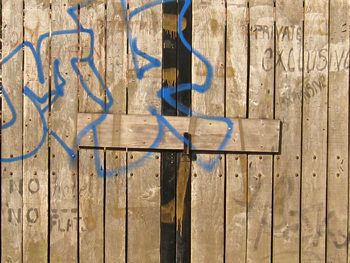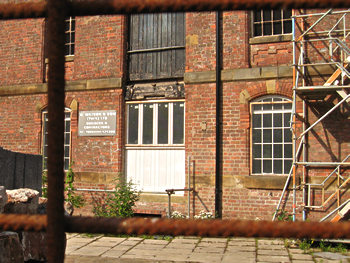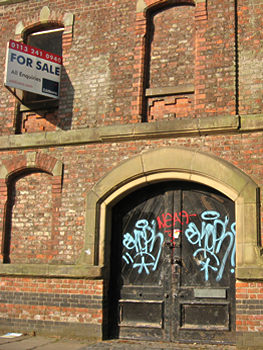June 2011
What else could you be?
In 2007 these gates to the Bonding Warehouse became photogenic, decorated with text.

The wooden bar across them asked ‘What else could you be?’ – which seemed at first glance like a philosophical enquiry, looking deep into the unfulfilled dreams of the passer-by.
More careful reading of the text around it made it clear that ideas for and comments on the building’s future had been written on the temporary ‘graffiti wall’ of its gate, in response to the news in July of that year that the building had been sold to a developer.
The writers on the gate said ‘No hotel’, ‘No flats’. This statement made in protest now looks more like a prophecy.

Four years on and there are no flats here. No hotel either. Mr Legard, who bought the building in 2007, put it back on the market in June 2011 for much less than he paid for it. His plans to convert it to flats/offices have been abandoned, because of the recession.
The hotel idea was put forward in 2007 by David Hattersley. Perhaps if Mr Hattersley had bought it back in 2007 the Bonding Warehouse would have been all restored and plush by now. Or perhaps not.
This is the gate now, in June 2011. The old lettering is still visible under the garish graffiti tag.

At the height of the booming market, people were fighting over this place, with an amusing argument in the local paper between Mr Hattersley and another local businessman, Marti Dix. Mr Hattersley jeered at Mr Dix’s idea to use the building for retail purposes: ‘It all sounds like a load of old hippy rubbish to me … It would go pop faster than I could say Woodstock.’ And Mr Dix condemned Mr Hattersley’s planned luxury hotel as a ‘yuppie playpen’. (War of words in The Press.)
The building has been empty and unused for years, and might be York’s most well-known disused building/eyesore, if it weren’t for the White Swan, Piccadilly (which has been vacant for decades on end – since the 80s I think – possibly the 1880s).

One of the ideas mentioned in the recent piece in the press is that the Bonding Warehouse could house a museum to York’s chocolate-making heritage. This is a great idea which keeps resurfacing every now and then. There were at one time plans to use Rowntree Wharf for that purpose, before it ended up being converted into flats and offices. But there’s a story in the press suggesting a far less attractive building in King’s Square is to be used as a museum on the history of chocolate (*see update, below), and I don’t suppose we need two of them.
These large industrial buildings make good gallery spaces, and it would make many people happy if the Bonding ended up as an arts/crafts venue. But realistically, there’s probably not enough money in arts and crafts. Though the more I think about this the more it appeals. What we need is someone connected with the visual arts, with a Yorkshire connection, who’s got loads of money and likes Victorian architecture. It would be grand to have a smaller version of the converted Salt’s Mill at Saltaire, full of David Hockney’s paintings of the Yorkshire Wolds. Anyone got his number … ?
Update, 2014
The building is now being redeveloped. For more information on recent happenings, and some Bonding Warehouse memorabilia, and history, see all pages tagged ‘Bonding Warehouse’.
Links etc
Bonding Warehouse in York is repossessed – The Press, 2 June 2011
‘Big opportunity’ in sale of York’s Bonding Warehouse – 7 June 2011
Letter in The Press, from 2007, regarding the history of the building
*Update: The confectionery-related attraction has indeed found a home in King’s Square (where the previously ugly building is now looking quite smart), and is due to open in 2012





Hi there
Just a quick (and belated) comment. The building is the City of York) Bonded Warehouse. The “Bonding Warehouse” was the name of the former pub/restuarant. There is no such thing as a “Bonding Warehouse” (unless it’s a warehouse to hold bondings) – that name is another example of the fake history in which our city is so rich. If anyone’s interested in real history there’s a very good article on how this building came to be in the former inland port of York by Colin Sheppard in “York Historian” 26 (2009).
Cheers
Richard Taylor
City Archivist
I put city of York bonded warehouse into Google and all it brings up is reference’s to the bonding warehouse .. Any chance of a link to the real history of the bonding warehouse? Seen as the last 30 ish years doesn’t exist?
What’s driving the “no such thing” comment?
I can see the logic in terms of the “bonded warehouse” function of the building but its name is the “Bonding Warehouse”. I base this upon the English Heritage listing ref. 1256638, the name City of York council has use for recent planning purposes.
It’s note worthy that English Heritage does record “Formerly known as: Bonded Warehouse SKELDERGATE” in the listing detail but there is another interesting reference too: “curved gable over centre bay, inscribed: “BONDING WAREHOUSE/ AD 1875″”.
I’ve seen recent pictures, currently masked by scaffolding, with the inscription. It may be a presumption that detailed description relates to historic features, historic pictures (pre-1977!) or archive drawings could be an interesting cross reference.
It seem unnecessary to suggest this is “fake history” when simple references lead into another interesting story. I’m not an archivist but it seems clear to me that this building has a history with at least two names and a growing number of uses.
I have to agree with the excellent comment from Colin Durrans. Richard Taylor’s assertion is wrong. “Bonding warehouse” is simply a variant of the term “bonded warehouse”. It is encountered less often, but is no less correct – certainly C19th newspapers are full of the term “bonding warehouse”, e.g.:
– “York Council Meeting”, York Herald, 9 September 1871, p. 9 (“A communication had been received from the secretary of the Inland Revenue with reference to the establishment of a bonding warehouse in York”).
– “Shocking Occurrence”, Birmingham Daily Post, 7 August 1872, p. 8 (“Three men have been buried alive and two killed by the fall of a roof in a bonding warehouse in Halifax”).
The York bonded warehouse calls *itself* a bonding warehouse in the dated gable inscription noted by Colin, and others (including the owners of the nightclub) have simply followed suit.
In more general terms, I do find the talk of “real” and “fake” history troubling. It seems judgemental and perhaps even rather elitist. “Fake” suggests a deliberate intention to deceive. History is not a single objective thing that is out there, it is a construction, a matter of memory, document, perceptions, stories and myths, and all the things that help people make sense of the world. That doesn’t mean that all interpretations of the past are equally valid (thus we can appeal to reliable evidence to establish that “bonding warehouse” is a perfectly correct term to use of the building here in York) but it does mean that history speaks in many ways and in many voices. This site is an excellent example of that. Even if Richard was right and the “bonding warehouse” title was a creation of the last 30 years, it would still be part of this building’s history, and it would be real history, not “fake”.
Clearly plenty of interest in real history in the above replies. Thank you for your comments.
I have a photo of the inscribed gable mentioned, just uploaded it here.
I haven’t read the particular article mentioned but know that the York Historian is interesting and informative. Perhaps the article mentioned could be made available online?
Regarding “real” history, I think Ralph is right: “History is not a single objective thing”. There’s plenty of “real” history on these pages – among the more generalised waffle – and I know that many people appreciate it and the work that has gone into the site over the years.
Going back to the original comment above, and the mention of York Historian 26 – I’ve searched in the online library catalogue for York libraries, and looked on the shelves in York Explore, and can’t find it, or any evidence that the library has it. Perhaps a copy could be made more readily available in York Explore?